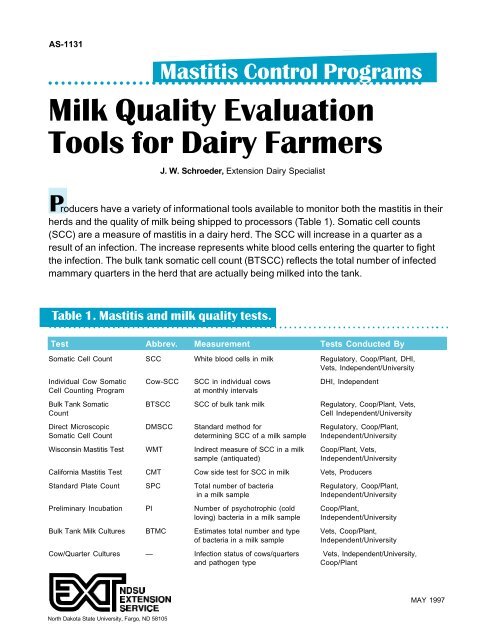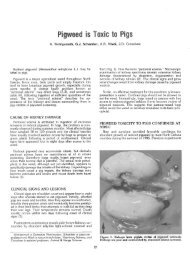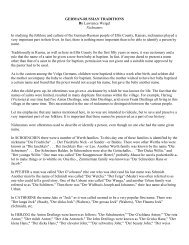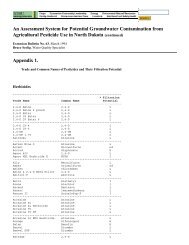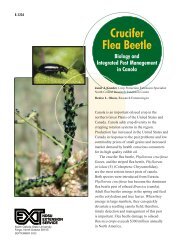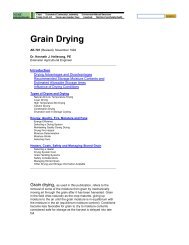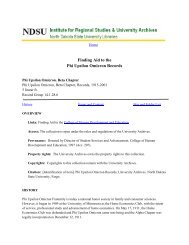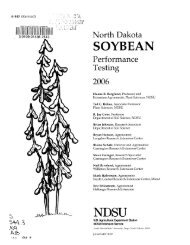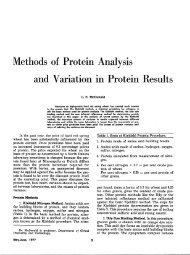Mastitis Control Programs: Milk Quality Evaluation Tools for Dairy ...
Mastitis Control Programs: Milk Quality Evaluation Tools for Dairy ...
Mastitis Control Programs: Milk Quality Evaluation Tools for Dairy ...
Create successful ePaper yourself
Turn your PDF publications into a flip-book with our unique Google optimized e-Paper software.
AS-1131<strong>Mastitis</strong> <strong>Control</strong> <strong>Programs</strong><strong>Milk</strong> <strong>Quality</strong> <strong>Evaluation</strong><strong>Tools</strong> <strong>for</strong> <strong>Dairy</strong> FarmersPJ. W. Schroeder, Extension <strong>Dairy</strong> Specialistroducers have a variety of in<strong>for</strong>mational tools available to monitor both the mastitis in theirherds and the quality of milk being shipped to processors (Table 1). Somatic cell counts(SCC) are a measure of mastitis in a dairy herd. The SCC will increase in a quarter as aresult of an infection. The increase represents white blood cells entering the quarter to fightthe infection. The bulk tank somatic cell count (BTSCC) reflects the total number of infectedmammary quarters in the herd that are actually being milked into the tank.Table 1. <strong>Mastitis</strong> and milk quality tests.Test Abbrev. Measurement Tests Conducted BySomatic Cell Count SCC White blood cells in milk Regulatory, Coop/Plant, DHI,Vets, Independent/UniversityIndividual Cow Somatic Cow-SCC SCC in individual cows DHI, IndependentCell Counting Programat monthly intervalsBulk Tank Somatic BTSCC SCC of bulk tank milk Regulatory, Coop/Plant, Vets,CountCell Independent/UniversityDirect Microscopic DMSCC Standard method <strong>for</strong> Regulatory, Coop/Plant,Somatic Cell Count determining SCC of a milk sample Independent/UniversityWisconsin <strong>Mastitis</strong> Test WMT Indirect measure of SCC in a milk Coop/Plant, Vets,sample (antiquated)Independent/UniversityCali<strong>for</strong>nia <strong>Mastitis</strong> Test CMT Cow side test <strong>for</strong> SCC in milk Vets, ProducersStandard Plate Count SPC Total number of bacteria Regulatory, Coop/Plant,in a milk sampleIndependent/UniversityPreliminary Incubation PI Number of psychotrophic (cold Coop/Plant,loving) bacteria in a milk sample Independent/UniversityBulk Tank <strong>Milk</strong> Cultures BTMC Estimates total number and type Vets, Coop/Plant,of bacteria in a milk sample Independent/UniversityCow/Quarter Cultures — Infection status of cows/quarters Vets, Independent/University,and pathogen typeCoop/PlantMAY 1997North Dakota State University, Fargo, ND 58105
The bacterial count is anotherprimary measure of milk quality.Bacteria are present in milk as aresult of milking infected mammaryquarters, contaminationfrom the environment duringmilking, dirty milking equipment,and growth during milk storage.The majority of bacteria presentin milk are as a result of contaminationfrom the environmentand dirty equipment. Thecontribution from infectedmammary quarters generally issmall by comparison. <strong>Milk</strong>ingwet, dirty udders, together withpoorly cleaned and sanitizedinflations, milking claws, hoses,pipelines, and bulk tanks areprimary sources of high bacterialcounts. Overuse of inflationsleads to cracking of the rubberand ideal areas <strong>for</strong> bacteria togrow and is a frequent cause ofhigh bacterial counts.The types of in<strong>for</strong>mation derivedby analysis of a milk sample byone or more tests designed todetermine either SCC or bacterialcontent are listed in Table 2.No one test simultaneouslydetermines both. Analysis ofbulk tank milk samples yieldsin<strong>for</strong>mation on the herd, whileanalysis of milk samples fromindividual cows/quarters yieldsspecific in<strong>for</strong>mation about thatcow/quarter. Whole herd in<strong>for</strong>mationcan also be obtained bytesting individual milk samplesfrom all cows in the herd.Bulk Tank <strong>Milk</strong> TestingTests run on bulk tank milksamples fall into three categories:1) regulatory tests, 2) coop/plant quality premium tests, and3) in<strong>for</strong>mational tests. Regulatorytests establish that the milkbeing shipped by producersmeets the legal minimumquality standards established bythe Food and Drug Administration(FDA) and adopted by statedepartments of health. Theseregulations are in the Pasteurized<strong>Milk</strong> Ordinance (PMO).Tests are conducted <strong>for</strong> SCC,bacterial numbers, the presenceof antibiotics, and the presenceof added water. The upper legal2limit <strong>for</strong> SCC is 750,000 cells/ml.(as of January 1, 1997) Theprimary bacterial count used isthe standard plate count (SPC),sometimes referred to as theplate loop count. The upperlegal limit <strong>for</strong> SPC is 100,000bacteria/ml.Coop/plant quality premiumtests include determination ofSCC and bacterial numbers,generally by both the SPC andpreliminary incubation (PI)methods. Minimum standards toreceive bonus payment <strong>for</strong>quality milk will vary among milkprocurement agencies, but ingeneral bonus payments startat 300,000 somatic cells/ml and10,000 bacteria/ml by both theSPC and PI methods. There aregenerally other requirementsthat must be met, such asabsence of antibiotics.In<strong>for</strong>mational tests include theregulatory and coop/plantquality premium tests. In addition,many veterinarians andother laboratories do bulk milktank cultures (BTMC). This testestimates the total number ofbacteria in the bulk tank milkand provides in<strong>for</strong>mation as tothe specific types of bacteriapresent. It is a good place tostart when troubleshooting aherd mastitis problem. The SPCand PI tests do not reveal thespecific types of bacteriapresent.
Table 2. In<strong>for</strong>mation derived from mastitis and milk quality tests.Test Importance of In<strong>for</strong>mation DisadvantagesBTSCC 1. Indicator of herd mastitis prevalence. 1. No indication of which cows/quartersare infected.2. No indication of pathogens involved.3. Poor monitor of environmental mastitis.SPC 1. A monitor of milking equipment sanitation, 1. No indication of bacterial types.milking time hygiene, and efficiency of milk 2. No indication of specific source ofcooling.contamination.PI 1. Indication of bacterial contamination 1. No indication of causative agents.from environmental sources.2. No indication of the specific2. Low values necessary <strong>for</strong> quality environmental source.bonus payments.Individual Cow SCC 1. Monitor of subclinical mastitis in a cow. 1. No indication of causative agents.2. Can be used to assess subclinical mastitis 2. Poor monitor of environmental mastitis.in a herd3. Poor indicator of clinical lmastitis.3. In<strong>for</strong>med management decisions (culling).4. Assess monetary losses associated withsubclinical mastitis.CMT 1. Inexpensive, rapid, and subjective evaluation 1. Interpretation is difficult.of quarter SCC at cow side.2. Relative numbers of pathogens arepoorly related to infection prevalence.3. The source of organisms other thancontagious pathogens is not indicated.BTMC 1. Estimates SPC. 1. Interpretation is difficult.2. Detects presence of specific pathogen types. 2. Relative numbers of pathogens are3. Indicates primary bacterial contaminants. poorly related to infection prevalence.4. Can be used to evaluate milking time hygiene. 3. The source of organisms other thancontagious pathogens is not indicated.Cow/Quarter 1. Only method that determines infection 1.Costly.Cultures status of a cow/quarter. 2. Requires special training to collect and2. Identifies specific causative agents in analyze samples.clinical and subclinical mastitis.3
Testing <strong>Milk</strong> From Individual CowsThe primary purpose <strong>for</strong> testingmilk from individual cows/quarters is to evaluate mastitis.None of the tests applied to milkfrom individual cows are usedby regulatory agencies or coop/plant quality premium programs.Individual cow tests are simplyin<strong>for</strong>mational and the nextlogical step <strong>for</strong> troubleshootingherd mastitis problems.The most widely used program<strong>for</strong> determining the SCC of milkfrom individual cows is the <strong>Dairy</strong>Herd Improvement (DHI)-SCCprogram. Some independentmastitis testing laboratoriesoffer a similar service, andsome milk procurement agencieswill test milk samples fromindividual cows <strong>for</strong> SCC. TheDHI-SCC program determinessomatic cells in composite milkat monthly intervals. These datacan be used to determine whichcows are likely to be infected,but they cannot be used todetermine which of the fourmammary quarters are infectedor the type of pathogen causingthe infection. The Cali<strong>for</strong>nia<strong>Mastitis</strong> Test (CMT) is the mostwidely used cow-side test <strong>for</strong>estimating the SCC of individualquarters.Somatic cell counts measureinflammation and are an indirectmeasure of the presence orabsence of infection. The trueinfection status of a cow/quartercan only be determined bymicrobiological analysis (culturing)of aseptically taken milksamples. <strong>Milk</strong> samples to betested can be either compositesamples (an equal volume ofmilk from each quarter is drawninto the same tube) or individualquarter samples. This type oftesting determines the presenceor absence of pathogens andthe type of pathogen. Resultsfrom multiple samples takenover time are more reliableindicators of infection statusthan results from a singlesample. When culturing a singlemilk sample, four types ofresults are possible: 1) thesample yields the correct result;2) a pathogen is isolated, butthe quarter is truly not infected– a false positive; 3) nothinggrows (no isolation), but thequarter is truly infected – a falsenegative; and 4) the sample iscontaminated, three or morepathogen types grow and theresults are impossible to interpret– contaminated sample.The number of samples yieldingincorrect results will vary between10 and 20% of milksamples when routinely samplingcows. The percent incorrectsamples can be as high as30 to 50% if samples are onlyfrom clinical quarters.4
Conducting <strong>Milk</strong> <strong>Quality</strong> TestsBulk Tank <strong>Milk</strong> TestsRegulatory tests are conductedin laboratories operated by statedepartments of health orequivalent agencies or inlaboratories approved by theseagencies. The PMO indicatesthat milk from all herds will betested at least four times in anysix-month period. Somatic cellcounts are determined almostexclusively by electronic countingmethods using a series ofmilk samples with varying cellconcentrations. Cell numbers inthe standards are determinedby the direct microscopicmethod and the cell count isreferred to as the direct microscopicsomatic cell count(DMSCC). The DMSCC methodis considered the standardmethod to which all other cellcounting methods are compared.Even with calibratedmachines there is approximately15% error in any single numbergenerated. A 15% error meansthat a cell count of 100,000cells/ml could really be anywherebetween 85,000 and115,000 cells/ml.The standard plate countmethod accurately determinesthe total number of bacteriapresent in a milk sample, but itdoes not determine the type ofbacteria present. To run theSPC, a precise volume of milk isadded to a given quantity ofmedia and the plate incubated<strong>for</strong> 24 hours. The number ofcolonies is accurately countedand expressed as bacteria/ml ofmilk. Other names often used todescribe the SPC are “loopcount” and “bacteria count.”Coop/plant quality premiumtests are generally conducted inlaboratories operated by thecoop or plant. Some tests maybe carried out in independentlaboratories, and some coops/plants may utilize the test dataderived by regulatory agencies.Most coop/plant quality premiumprograms determine SCCby electronic means and generallyuse a Fossomatic or equivalentmachine. The Fossomaticcounts the number of DNAparticles or somatic cell nuclei.Proper calibration of the machinesis essential. There is nosingle “standard milk sample” bywhich all machines are standardized.Most laboratoriesfrequently test the accuracy oftheir machines by comparingthe cell count generated to thevalue derived by the DMSCCmethod.Most coops/plants determinethe number of bacteria in milkusing both the SPC and PImethods. The value of the PIcount is that is gives a betterindication of the shelf life of fluidmilk. To determine the PI countthe raw milk sample previouslyused to determine the SPC is5
Individual Cow Testsincubated at 55 ° F <strong>for</strong> 18 hoursand then the bacterial count isdetermined using the SPCmethod.Veterinarians and others arefrequently interested in not onlythe number of bacteria presentin bulk tank milk, but also thevarious types of bacteria. A testthat is growing in use is bulktank milk culturing (BTMC). Incontrast to the SPC and PImethods, BTMC is not standardized,not quantitative, andexact methods vary amonglaboratories. A common practiceis to spread approximately .01ml of milk evenly over the entiresurface of an esculin blood agarplate. Some laboratories usemedia that is selective <strong>for</strong>growth of staphylococci, streptococci,coli<strong>for</strong>ms, or mycoplasmain addition to the esculin bloodagar. The total growth on esculinblood agar approximates, but isnot identical to, the SPC. Thetest is primarily used to determinethe presence of contagiouspathogens in the dairy.The primary contagious pathogensare Staphylococcusaureus, Streptococcusagalactiae, and Mycoplasmaspp.Individual cow SCC are mostfrequently determined in DHIlaboratories, but independentlaboratories do offer this service.Cells are counted electronically,generally using aFossomatic machine. The DHI-SCC program generally reportsthe values as the Linear Score,but some report the value asthousands of cells (i.e. 100,000= 100). The scale <strong>for</strong> linearscore is from 0 to 9, where alinear score of 4 is equal to200,000 cells/ml and linearscore 6 is equal to 800,000cells/ml. The linear score ispreferred as it can be relateddirectly to production losses.Each increase of 1 in linearscore corresponds to a doublingof SCC and a milk loss of 400lbs/lactation (1.5 lbs/day) onsecond lactation or older animalsand 200 lbs/lactation (.75lbs/day) on first lactation animals.High SCC quarters can bedetermined at cow side usingthe Cali<strong>for</strong>nia <strong>Mastitis</strong> Test(CMT). The CMT test is anestimate of the SCC.Veterinarians usually conductbacterial analysis of milksamples from individual cowsand quarters in their ownlaboratories or they use theservices of independent oruniversity laboratories. Theprimary purpose of culturingmilk from individual cows is todetermine the infection status ofthe cow or quarter and todetermine the specific pathogensinfecting the herd. <strong>Milk</strong>samples <strong>for</strong> culture must betaken with great care. Teatsmust be clean and dry and theteat end thoroughly scrubbedwith alcohol pads prior tocollection. Either composite milkfrom all four quarters or individualquarter samples can betested. The most accuratemethod is to culture individualquarter samples. Compositemilk samples are often used inan attempt to reduce the cost oftesting. However, compositemilk samples have limitedmicrobiological value and theydo not reveal which quartersare infected.6
Using the In<strong>for</strong>mation toManage <strong>Mastitis</strong> and <strong>Milk</strong> <strong>Quality</strong>The production of quality milkbegins with the understandingthat mastitis must be controlledand sanitary conditions mustexist throughout the cow’senvironment. Bulk tank milktests <strong>for</strong> SCC, SPC, and PIprovide producers valuablein<strong>for</strong>mation about the currentstatus of mastitis and sanitationin their herds. Coop/plantincentive programs have greatlyincreased producers’ awarenessof these quality tests. Realisticgoals are BTSCC of less than200,000 cells/ml and SPC andPI counts of less than 5,000bacteria/ml. Many dairymenconsistently produce milk withSCC less than 100,000 cells/mland less than 5,000 bacteria/ml.A question frequently asked iswhether or not SCC can get toolow. The SCC goals suggestedare in the range of countsassociated with uninfectedquarters and are not physiologicallyabnormal.Somatic cell counts are reducedby controlling mastitis and, morespecifically, subclinical mastitis.The BTSCC is a function of thepercentage of quarters infectedin the dairy herd. The contagiousmastitis pathogens, suchas S. aureus, S. agalactiae, andMycoplasma spp. are frequentlycauses of subclinical mastitis,high percentage of quartersinfected, and BTSCC of 500,000cells/ml or greater. On occasion,high SCC herds are found tohave a significant problem withthe environmental streptococci.The BTSCC is the first clue tothe amount of subclinical mastitisin the herd, and the DHI-SCCprogram can be used to identifythe high SCC cows within theherd. A general rule is that cowswith linear scores of 4 or greaterare very likely to be infected andthe goal should be to have 90%of the cows with linear scores of3 or less.Many producers try to makecomparisons between DHI-SCCherd means and BTSCC derivedfrom coops/plants. Directcomparisons are generally notvalid. Somatic cell counts arevery dynamic within individualcows <strong>for</strong> a given infection statusand the infection status of theherd is variable from day to day.Bulk tank milk SCC representsthe milk from cows actuallymilked into the bulk tank, whileDHI-SCC herd means mayinclude cows whose milk wasdiscarded. Samples may havebeen taken on different days,derived from a different numberof milkings, analyzed in differentlaboratories, and cells countedby different methods.The specific bacterial cause ofhigh SCC is important in<strong>for</strong>mation<strong>for</strong> purposes of implementinga control procedure. Contagiouspathogens are reduced byteat dipping with efficaciousproducts, dry cow therapy, useof single service towels <strong>for</strong>udder preparation, and properlymaintained and functioningmilking machines. Environmentalmastitis is reduced by minimizingexposure to the environmentalpathogens in the environment(inorganic beddingmaterials), milking clean dryteats and udders, and minimizingliner slips during milking.Bulk tank milk cultures are aquick way to determine if thecontagious pathogens arepresent in the herd. The presenceof contagious pathogensin bulk tank milk almost alwaysindicates infected mammaryquarters in the herd. However,the absence of contagiouspathogens does not prove that7
no cows are infected. Environmentalpathogens present inbulk tank milk have multipleorigins and are more likely areflection of milking time hygienethan infected cows. Totalbacterial numbers from BTMCshould approximate the SPC,provided quantitative techniquewas used to determine BTMC.Interpretations based on asingle bulk tank sample can bevery misleading. Multiplesamples over time are highlyrecommended to obtain maximumvalue of BTMC.The relative numbers of thevarious pathogens determinedusing BTMC can be useful whentrying to determine the possiblecause of high SPC or PI counts.High SPC or PI counts are mostoften the result of dirty equip-ment, poor milking time hygiene,or improper cooling ofmilk. On occasion high SPC orPI counts may be the result ofintramammary infections in thedairy herd. A high prevalence ofquarters infected with S.agalactiae or the environmentalstreptococci can result in a highSPC. Spikes in PI count can, onoccasion, be attributed tosevere coli<strong>for</strong>m infections thatget milked into the bulk tank.Numbers of coli<strong>for</strong>m bacteriacan reach several million permilliliter in the infected quarterand often the cow shows nosigns of clinical mastitis until thefollowing milking. The milk fromsuch cows represents a highnumber of coli<strong>for</strong>m bacteriaentering the bulk tank andcoli<strong>for</strong>m bacteria are a primecontributor to PI count.NDSU Extension Service, North Dakota State University of Agriculture and Applied Science, and U.S. Department of Agriculturecooperating. Sharon D. Anderson, Director, Fargo, North Dakota. Distributed in furtherance of the Acts of Congress of May 8 and June30, 1914. We offer our programs and facilities to all persons regardless of race, color, national origin, religion, sex, disability, age,Vietnam era veterans status, or sexual orientation; and are an equal opportunity employer.1.5M-5-97This publication will be made available in alternative <strong>for</strong>mat upon request to people with disabilities (701) 231-7881.


